Light tank M551 Sheridan (USA)
AR / AAV program
In 1959, the army launched a new Armored Reconnaissance / Airborne Assault Vehicle (AR / AAV) development program for the Armored Reconnaissance / Airborne Assault Vehicle. The new model was supposed to enter the armored cavalry and airborne units, where he was to replace the light tanks M41 Walker Bulldog and self-propelled guns M56 Scorpion, respectively.
At the request of the customer, the AR / AAV machine had to weigh no more than 10 t and have small dimensions, which was necessary for transportation by air and landing. The armament was supposed to ensure the fight with the existing medium tanks of the potential enemy at any time of the day. In fact, it was a light floating tank with bulletproof armor and powerful weapons. Subsequently, the requirements for the project changed. In particular, in order to achieve the required combat qualities, the permissible combat mass had to be increased one and a half times.
According to initial plans, 1,05 billion dollars and more than 2400 tanks should have been spent on the AR / AAV program. However, later the plans changed - the cost of the program increased, and the amount of equipment decreased.
In the fall of 1959, 12 companies with several projects joined the AR / AAV program. In December, the Pentagon chose the two most successful proposals, one of which came from Cadillac Gage (a division of General Motors). A few months later, the participating companies submitted preliminary designs. In June 1960, Cadillac was recognized as the winner of the AR / AAV program. Her project, adopted for further development, received the working index XM551. Later the tank received a name in honor of General Philip Sheridan.
The following months were spent on project development, construction and testing of individual components. Also, engineers and the military had to spend time arguing. According to the project, the XM551 was to carry a complex of weapons CVWS (Combat Vehicle Weapon System) with a large-caliber launcher. This feature of the tank became an occasion for criticism, and its supporters had to defend their point of view until 1962.
In the summer of 1962, the first prototype was built. On the chassis of the M41 tank, a full-time Sheridan combat compartment was installed. The development of new missile-cannon weapons took several years, which threatened the overall progress of the project. However, work continued.
In the summer of that year, the first series of three experimental XM551 tanks was tested. In 1963-64 two more prototype series appeared. As tests were carried out, various changes were made to the design that affected certain tank elements. However, the general provisions of the project did not change. At the beginning of the 1965, the 12 experimental XM551 was built, which became the standard for the next series.
In the spring of 1965, a contract appeared for serial production of M551 tanks; Cadillac Gage became the main contractor. Also involved in the release of several other organizations. In May 1966, an order was issued for the adoption of a light tank for service. In parallel, the industry received instructions for improving the tank, which should have been completed already during production.
Design features
The light tank M551 Sheridan was built in a classic layout using proven solutions. At the same time, a lot of new ideas, components and technologies were used. In this regard, the Sheridan was noticeably different from other armored vehicles of its time.
After all the changes during the refinement, an armored body made of 7039 aluminum alloy was created. The welded tower received a homogeneous steel armor. The frontal projection of such a tank withstood 20-mm shells; other elements protected from 14,5-mm bullets. A collective anti-nuclear defense system and fire extinguishing equipment were provided.
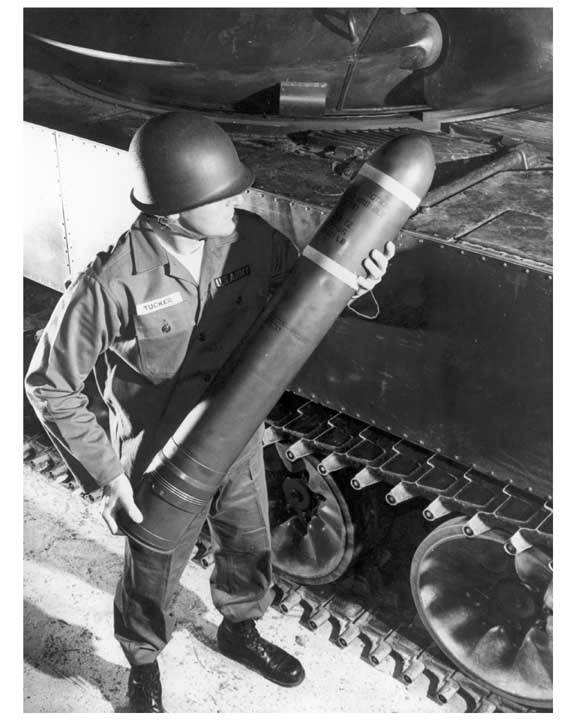
MGM-51 Shillelagh Tanker
A Detroit Diesel 6V53T diesel engine with 300 horsepower was placed at the rear of the tank. with transmission ТG-250 based on hydrodynamic gearbox. Onboard, five road wheels of large diameter with bandages were installed. Suspension - torsion bar. Front and rear pairs of rollers received hydraulic shock absorbers. During the refinement, the tank lost aft propellers, it was proposed to swim due to the rewind of the tracks. The increase in combat mass led to the need to ensure buoyancy due to a removable annular screen.
As part of the CVWS program, an armament complex was created on the basis of the M81E1 cannon-launcher with a caliber of 152 mm. The gun had a piston lock and barrel length 17,5 caliber. The gun was mounted on recoil devices with a hydraulic brake and spring knurled. The gun mount provided vertical guidance in the range from -8 ° to + 19,5 °.
Ammunition included unitary shots with a burning sleeve of several types. The high-explosive fragmentation M657, the card-based M625A1, the cumulative M409 and the incendiary M410 were created. The main anti-tank weapon was the MGM-51 Shillelagh guided missile. The transported ammunition included 20 shells of all types and 9 missiles in different styles.
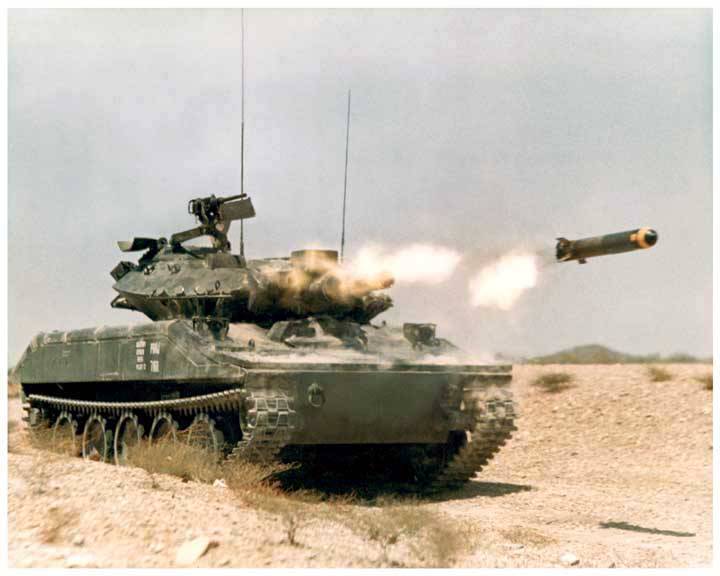
Rocket shooting
M551 had sights for the use of all weapons. The gunner had an M119 day and night M44 sight, as well as an M31 product for firing from closed positions. The gunner also worked with the control devices of the Shillaila complex. The missile control was carried out in semi-automatic mode: the gunner had to keep the target in sight, and the instruments generated commands for the rocket. MGM-51 missiles made it possible to increase the probability of hitting targets at 2-3 km distances.
Auxiliary weapons included a normal-caliber M73 machine gun coaxial with a cannon and a large-caliber anti-aircraft M2 on the commander’s turret. On the cheekbones of the tower there were two four-barrel smoke grenade launchers.
Other weapons options were also explored. In 1967, two prototypes were built with an alternative weapons. One carried an 76 mm tank gun, the other an 105 mm howitzer. However, the serial M551 received only the CVWS complex with the M81 gun.
The crew of the tank included four people with a traditional location. All workstations were equipped with the necessary hatches and viewing instruments. There was an intercom with an external telephone.
The M551 Sheridan had a length of 6,3 m with a width of 2,8 m and a height of 2,95 m. The combat mass of production vehicles was approx. 15,2 t. The tank could accelerate on the highway to 70 km / h or to 5 km / h on water. Cruising on the highway - 565 km. It could be transported by military transport aircraft and helicopters, as well as landing in various ways.
From the late seventies to the beginning of the nineties, several modernizations of equipment were carried out. According to their results, M73 machine guns were replaced with newer M240, thermal imaging sights AN / VSG-2 and new night-time devices for the driver appeared. Improved machines were designated M551A1 and M551A2.
Tanks in the service
The assembly of the first serial “Sheridans” started in 1966, and a year later they got into combat units. Production continued until 1970, and during that time 1662 light tanks were built. The total cost of the AR / AAV program, taking into account the development and the series, reached 1,3 billion dollars - the result was noticeably different from the plans.
Serial M551 was supplied only to the US Army, however, foreign orders might appear. For foreign armies, an export version of the tank, devoid of guided missiles, was offered. Great Britain and Australia became interested in the technology and tested it at their testing sites, but were not satisfied. The United States remained the only Sheridan operator.
The first new equipment received the armored cavalry units. The cavalry squadron from the land division relied 27 tanks - 9 for each of the 3 companies. Separate armored cavalry regiments included three such squadrons with 27 tanks in each and 3 vehicles for headquarters. The airborne units were rearmed in a similar way. Moreover, most of the light tanks received just infantry and tank divisions.
New equipment was distributed between parts both in the United States and at foreign bases. Fast enough tanks appeared in all strategic directions. Since 1966, the issue of sending parts to the M551 in Vietnam to participate in hostilities has been considered.
Sheridans in battle
Until the middle of 1968, the sending of light tanks to war was the subject of controversy. Serial cars have not yet fully met the requirements due to problems with optical instruments, the lack of a projectile shell, etc. In addition, tank armoring raised questions: commanders doubted that such protection would ensure the survival of equipment in the typical conditions of the Vietnam War.
By the middle of 1968, all these shortcomings had not yet been fixed, but the command decided to send the equipment to Vietnam. The first batch of tanks lost guided weapons, instead of which they placed additional stacking for machine gun cartridges. For the characteristic features of the converted interior, such M551 received the nickname Two Box - “Two Boxes”. In the future, new tanks went through such alterations. In total, they rebuilt 226 machines.
The first M551 arrived in Vietnam at the very beginning of the 1969. 64 machines were distributed among several parts for different purposes, which made it possible to test the equipment in all the main roles. At the end of January, the first battle involving the Sheridans took place. During night watch on a fortified position, the crews of two tanks discovered the movement of the enemy and fired several shots, disrupting the attack.
According to the results of the first months of operation, it was decided to increase the number of M551 in Vietnam. By the beginning of 1970, in units at the same time there were about 200 of such tanks. In 1971, they began to gradually withdraw them, and the number of “active” equipment was constantly decreasing. In total, several hundred M551 tanks took part in the war. The order of Xnumx vehicles was destroyed by the enemy. Over 90 after damage were repaired and returned to service.
The next time, Sheridan participated in battles during the invasion of Panama in 1989. Four of these tanks were delivered to the battlefield in advance, and eight others were parachuted. One was damaged due to the breakdown of the parachute system, but the others helped the soldiers of the 82 Airborne Division solve the combat problem.
In August 1990, the 82 Division, with its armored vehicles, went to Saudi Arabia. During Desert Storm, M551 tanks participated in battles and used all available weapons. The successful use of the MGM-51 missile, which destroyed the Iraqi T-55 tank, is known.
Departure from the service
The fighting in the Middle East was the last major episode in the biography of the M551 Sheridan tank. By this time, numerous shortcomings of the machine, which interfered with its effective operation, became apparent. In the near future, a new similar model was expected to be replaced.
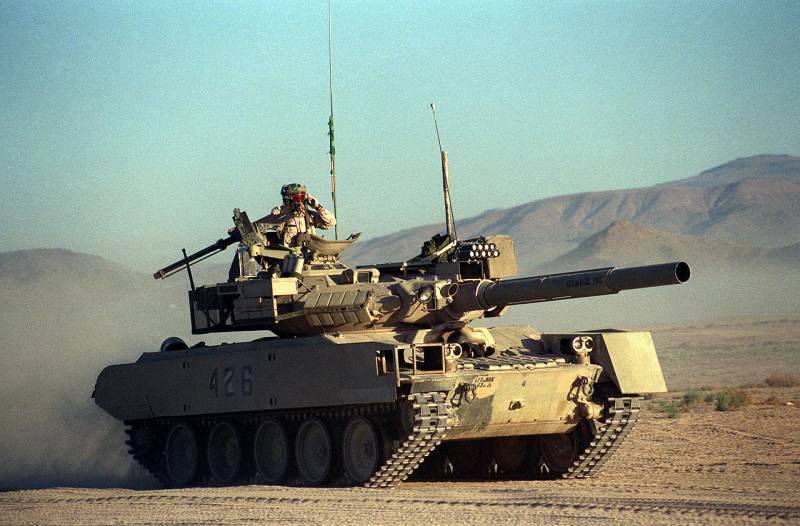
Tank "Sheridan" of the 60 motorized rifle regiment. Due to the body kit imitates the Soviet MBT T-80
Problems in the line of operation began in the sixties, and since then the situation has not changed dramatically. Already in the seventies, some parts were transferred from the imperfect M551 to other equipment. In the future, similar processes continued, and by the mid-nineties the Sheridans remained only with the 82 Airborne Division. In 1996, her battalion, armed with the M551, was disbanded.
Until 2004, the M551A2 tanks continued their service in the 60 infantry regiment at the training center in Fort Irwin. These vehicles were imitators of foreign armored vehicles and were used in exercises.
Over the course of their service, the M551 Sheridan light assault tanks proved to be mixed. They had high firepower and could hit various targets; low mass simplified the transfer and increased mobility on the battlefield. At the same time, the armor protected only from small-caliber artillery, but not from more powerful shells or mines. In addition, various problems with instrumentation, including with weapons controls.
By the mid-nineties, M551 Sheridan was hopelessly outdated in every way, which led to the decommissioning of the latest machines from linear parts. It was expected that a new light tank would soon appear to replace the decommissioned vehicles, but this did not happen. Thus, M551 so far retains the status of the last light tank of the US Army.
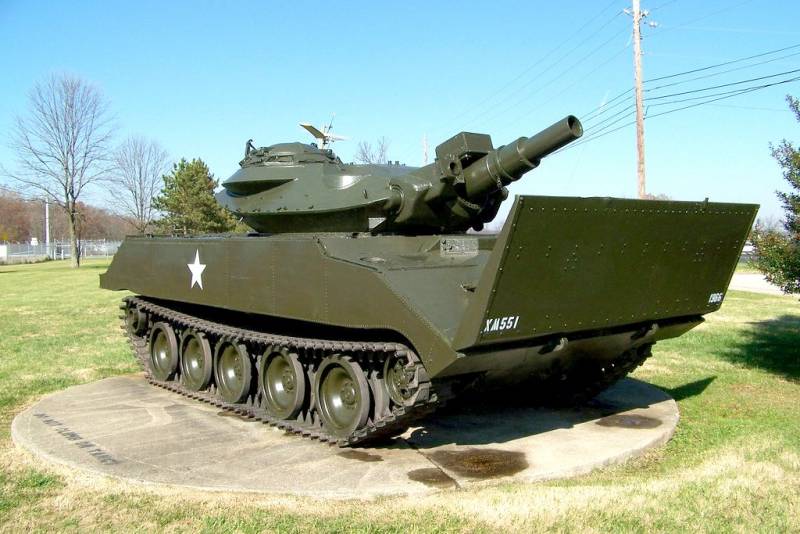
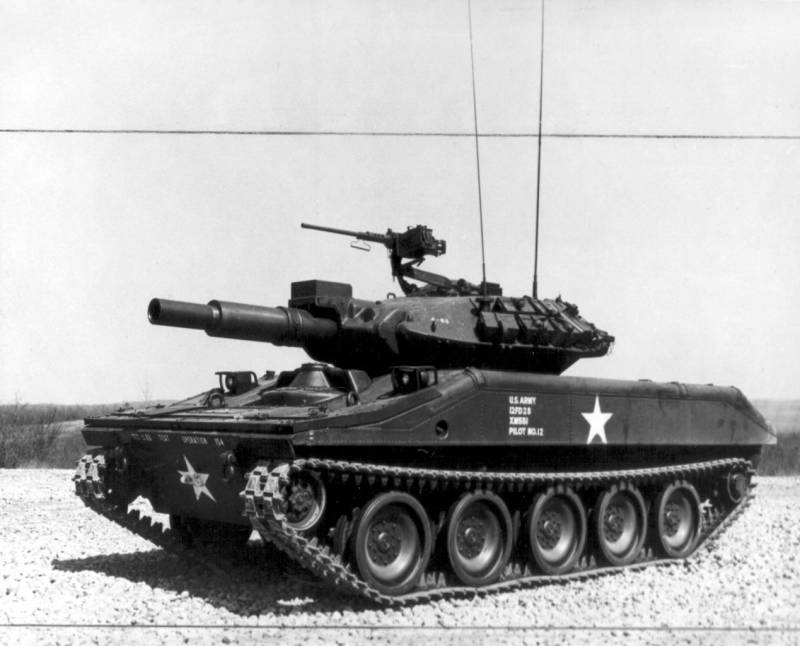
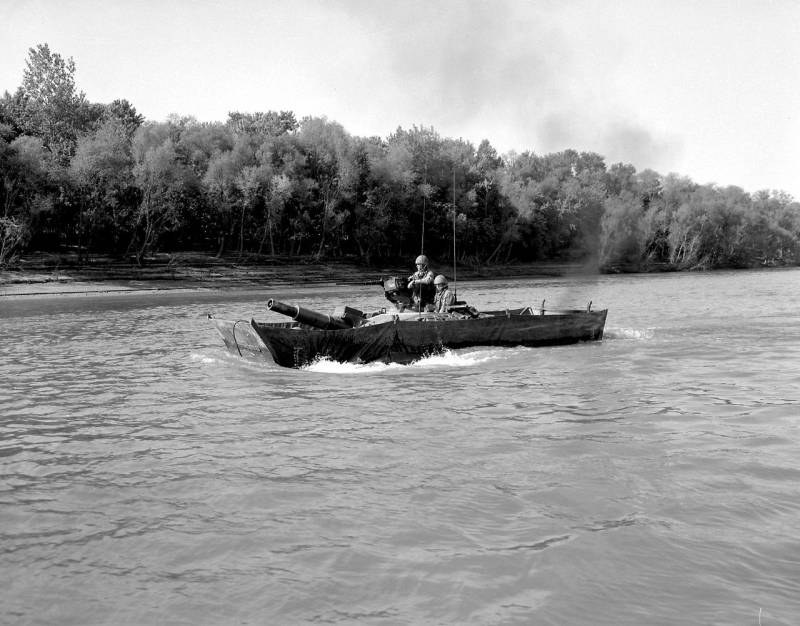
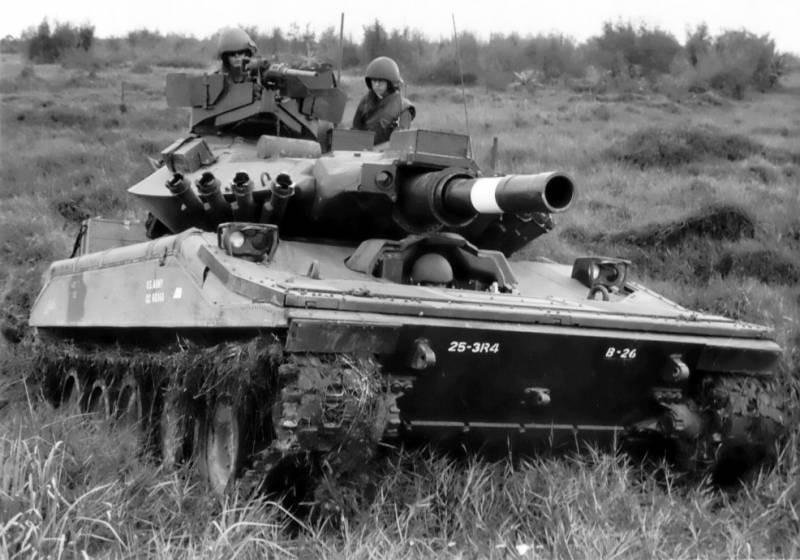
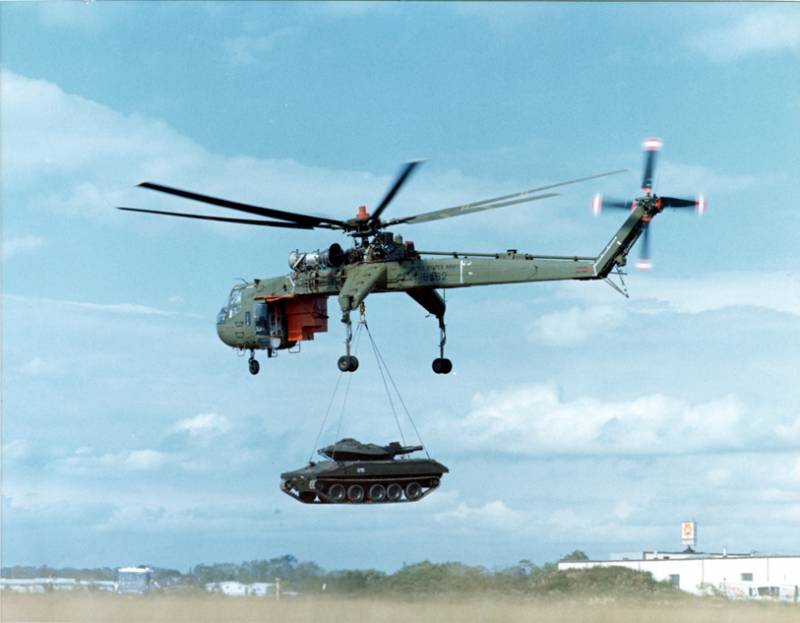
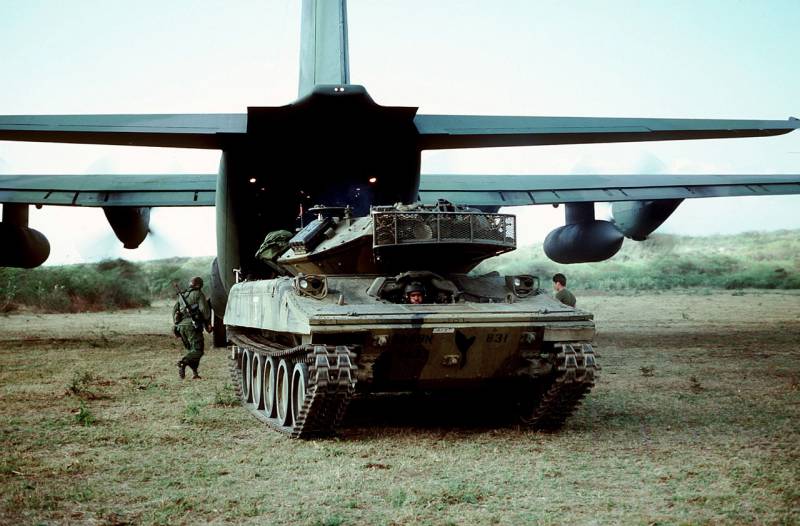
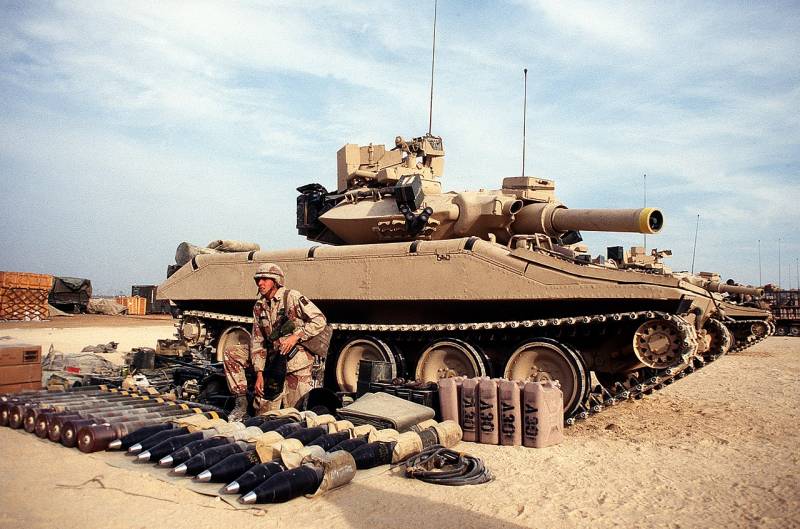
Information